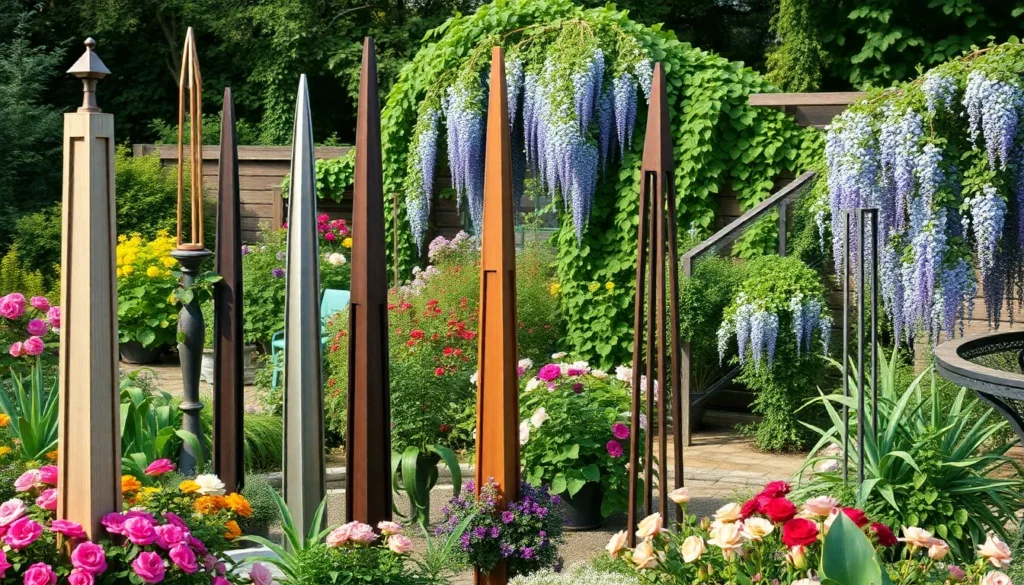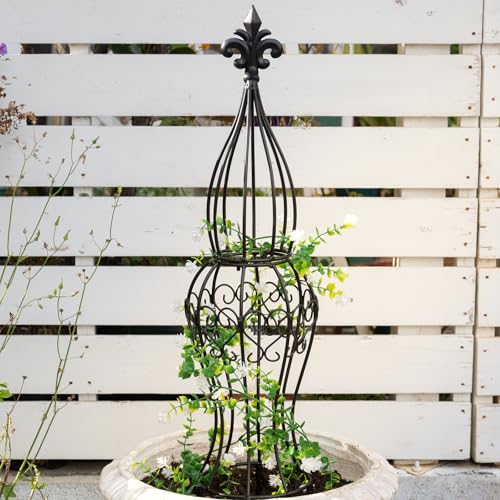Garden obelisks are transforming ordinary yards into stunning vertical masterpieces that’ll make your neighbors stop and stare. These elegant structures don’t just add height to your industry – they create dramatic focal points that draw the eye upward and make even small gardens feel grand and sophisticated.
We’ve discovered that the right obelisk can completely revolutionize your outdoor space, whether you’re looking to support climbing plants, create architectural interest, or establish a striking centerpiece. From rustic wooden designs that blend seamlessly with cottage gardens to sleek metal structures that complement modern landscapes, there’s an obelisk style that perfectly matches your vision.
The best part? You don’t need a massive budget or professional landscaping skills to incorporate these stunning vertical elements into your garden. We’ll show you creative ideas that range from simple DIY projects to impressive statement pieces that’ll turn your garden into the envy of the neighborhood.
Classic Wooden Garden Obelisk Ideas for Traditional Landscapes
Wooden garden obelisks bring timeless elegance to traditional landscapes with their natural warmth and classic appeal. These versatile structures complement established gardens while providing the perfect framework for climbing plants and vertical interest.
Cedar and Teak Obelisk Designs
Cedar obelisks offer exceptional durability with their natural resistance to insects and moisture. We recommend western red cedar for its beautiful grain patterns and ability to weather gracefully from golden brown to silvery gray. Construction typically involves four tapered legs connected by horizontal slats at 12-18 inch intervals, creating an elegant pyramid structure that reaches 6-8 feet in height.
Teak obelisks represent the premium choice for traditional gardens due to their superior weather resistance and rich golden color. These hardwood structures maintain their structural integrity for decades without treatment, making them ideal for supporting heavy climbing roses or clematis. Popular designs include lattice panels between the main supports, providing additional climbing surfaces while maintaining the classic obelisk silhouette.
Design variations include adding decorative finials at the top, incorporating curved braces between legs, or creating wider bases for enhanced stability. Both cedar and teak accept stains beautifully, allowing customization to match existing garden features like fences, pergolas, or outdoor furniture.
Rustic Reclaimed Wood Options
Reclaimed barn wood creates stunning obelisks with authentic weathered character that instantly adds vintage charm to traditional landscapes. We often source materials from old barns, fences, or shipping pallets, transforming these discarded pieces into functional garden art. The natural patina and nail holes tell stories while providing unique textures that new lumber cannot replicate.
Salvaged fence pickets work exceptionally well for creating narrower obelisk designs, particularly when supporting lightweight vines like morning glories or sweet peas. Construction involves selecting boards with similar weathering patterns and joining them with galvanized screws to preserve the rustic aesthetic while ensuring structural soundness.
Driftwood obelisks offer coastal charm for traditional gardens near water features or beach themed landscapes. These naturally sculpted pieces require careful selection for structural integrity, but their organic shapes create one of a kind garden features that serve as both plant supports and artistic elements.
Weather Resistant Treatment Techniques
Natural oil finishes penetrate wood fibers deeply, providing protection while maintaining the organic appearance that traditional gardens demand. We apply tung oil or linseed oil annually to cedar obelisks, improving their natural color while creating a barrier against moisture and UV damage. These treatments require reapplication every 12-18 months but preserve the wood’s natural texture and breathing ability.
Transparent wood stains offer longer lasting protection with semi annual application schedules. Marine grade stains provide superior defense against harsh weather conditions while allowing the wood grain to show through clearly. Color options range from natural cedar tones to deeper mahogany shades that complement brick pathways or stone features.
Traditional wood preservatives like copper naphthenate extend obelisk lifespan significantly when applied before assembly. This treatment penetrates deeply into the wood structure, preventing rot and insect damage for up to 10 years. Application requires proper ventilation and protective equipment, but the long term benefits make this investment worthwhile for permanent garden installations.
Modern Metal Garden Obelisk Ideas for Contemporary Spaces
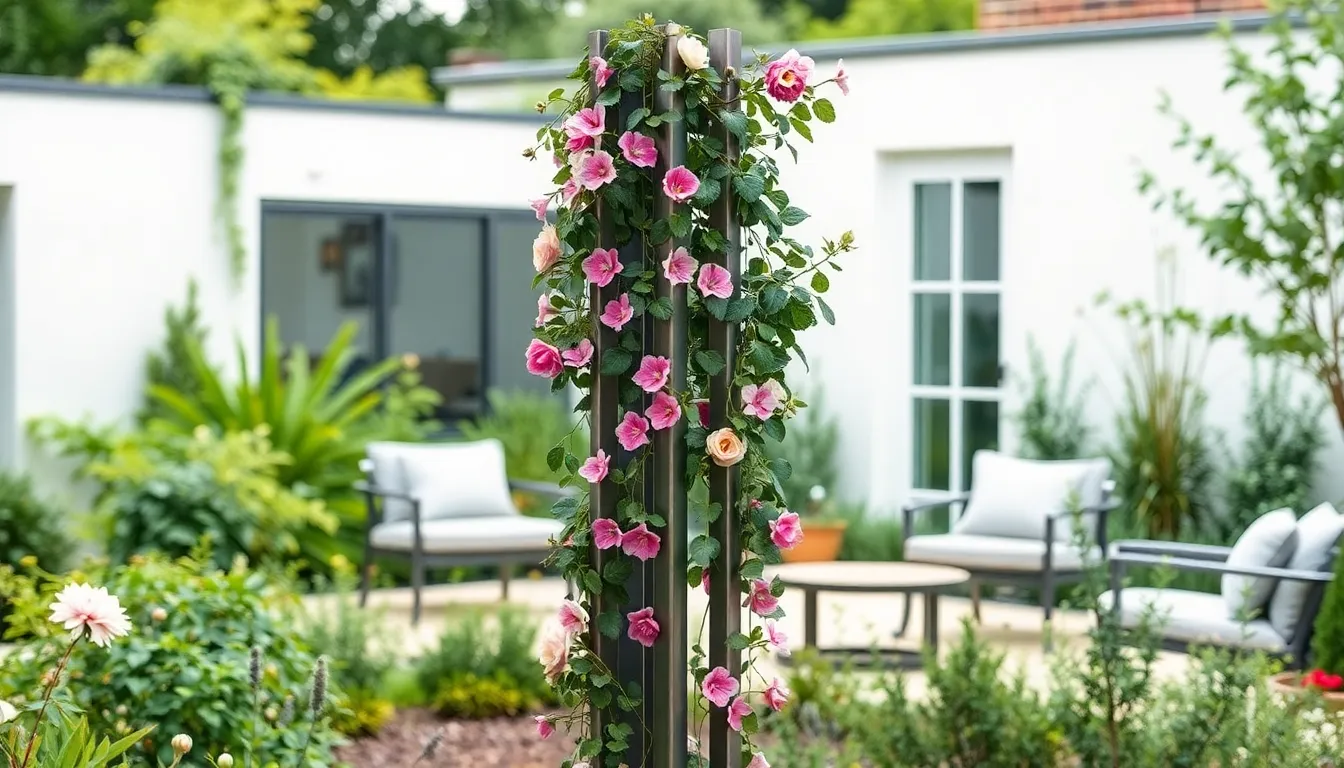
We’re transitioning from traditional wooden designs to explore sleek metal alternatives that perfectly complement today’s minimalist outdoor aesthetics. Metal garden obelisks offer unmatched durability while creating striking architectural elements in contemporary landscapes.
Sleek Steel and Iron Structures
Galvanized steel obelisks deliver exceptional longevity with their protective coating system that prevents rust and corrosion. These structures come in various sizes ranging from 4 feet to 8 feet tall, making them adaptable for container gardens, flower beds, and larger industry installations.
Wrought iron obelisks provide robust support for heavy climbing plants like clematis, roses, and honeysuckle vines. Their sturdy construction can handle winds up to 40 mph without compromising stability, while the classic metalwork adds sophisticated detail to modern garden designs.
Powder coated steel options combine durability with color versatility, offering finishes in matte black, charcoal gray, and bronze tones. These finishes resist fading and chipping for up to 10 years, maintaining their crisp appearance throughout multiple growing seasons.
Copper and Bronze Accent Pieces
Copper accent obelisks develop a natural patina within 6 to 24 months of outdoor exposure, transforming from bright copper to distinctive blue green hues. This weathering process creates unique character that enhances garden appeal while requiring zero maintenance from homeowners.
Bronze finished structures offer warm, earthy tones that complement both traditional and contemporary plantings. These pieces work particularly well with ornamental grasses, purple flowering plants, and silver foliage varieties that highlight the metal’s rich coloration.
Mixed metal designs incorporate copper elements with steel frames, creating visual interest through contrasting textures and colors. These combinations typically feature copper wire details, decorative bands, or finial accents that catch sunlight beautifully.
Powder Coated Aluminum Options
Lightweight aluminum obelisks weigh 60% less than comparable steel structures, making installation effortless for single person setup. Their reduced weight doesn’t compromise strength, supporting climbing plants up to 25 pounds per structure.
Weather resistant powder coating provides protection against UV rays, moisture, and temperature fluctuations common in outdoor environments. This coating technology ensures color retention for 8 to 12 years without requiring touch ups or refinishing.
Vibrant color selections include sage green, deep navy, warm white, and graphite black finishes that coordinate with modern outdoor furniture and architectural elements. These contemporary colors create cohesive design themes throughout outdoor living spaces.
DIY Garden Obelisk Ideas Using Repurposed Materials
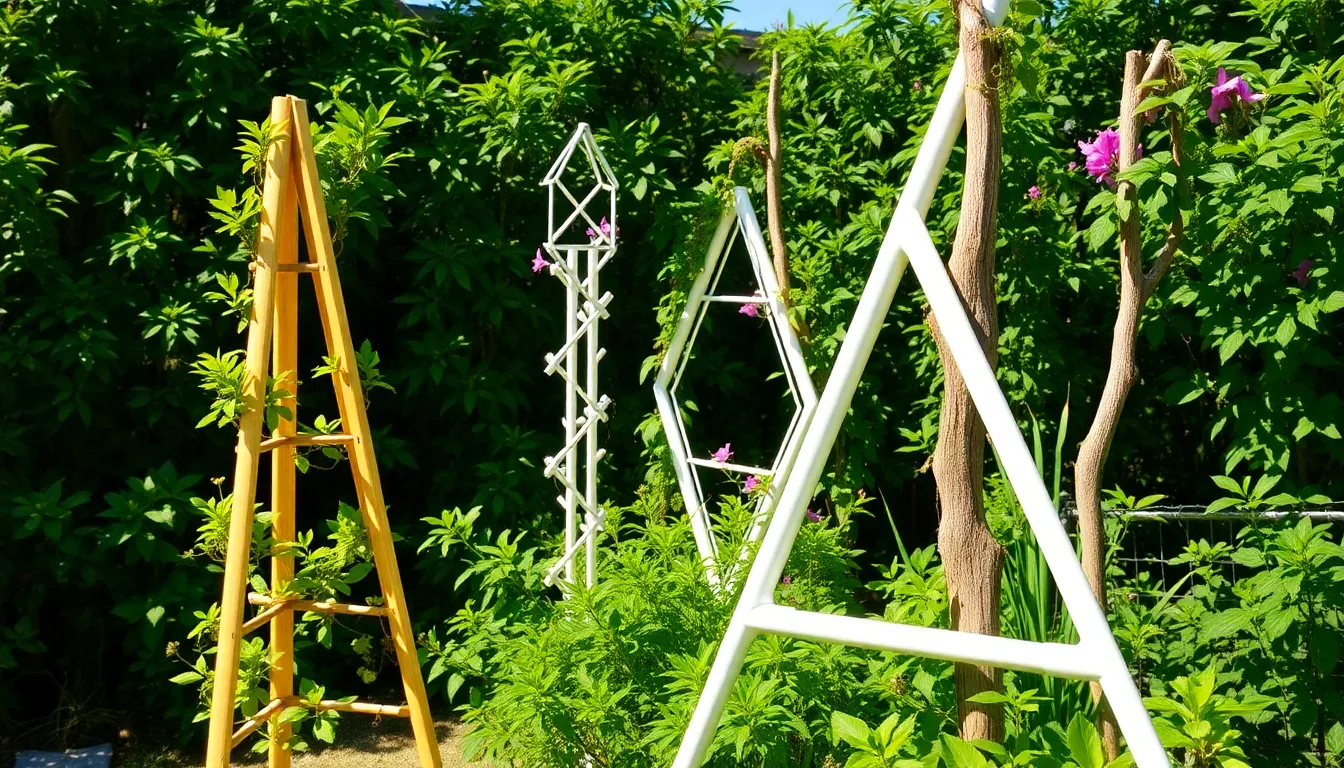
We’ve discovered that creating stunning garden obelisks doesn’t require expensive materials or professional carpentry skills. Repurposing everyday items transforms ordinary garden spaces while reducing waste and saving money.
Bamboo Pole Construction Methods
Bamboo poles offer lightweight durability that makes obelisk construction surprisingly simple for gardeners of all skill levels. We recommend gathering 4-6 bamboo canes between 6-8 feet tall and securing them at the top with strong twine or galvanized wire to create a classic teepee shape. The natural flexibility of bamboo allows these structures to sway gently with wind while maintaining stability for climbing plants like sweet peas, morning glories, and lightweight beans.
Creating a more elaborate bamboo obelisk involves connecting horizontal bamboo crosspieces at 12-inch intervals using zip ties or natural hemp rope. This technique provides additional support for heavier climbing vegetables such as cucumbers and pole beans. We’ve found that pre-drilling small holes in the bamboo prevents splitting when inserting screws or wire connections.
PVC Pipe Creative Answers
PVC pipes transform into modern garden obelisks through simple joint connections that require no special tools or expertise. We typically use 1-inch diameter PVC pipes cut into 2-foot sections and connect them with T-joints and elbow fittings to create geometric tower designs. These waterproof structures resist weather damage and provide years of reliable plant support without rotting or rusting.
Spray painting PVC obelisks with outdoor primer and acrylic paint allows complete color customization to match existing garden themes. We recommend using earth tones like sage green or warm bronze for natural garden settings, or bold colors like deep blue or charcoal gray for contemporary landscapes. Adding decorative PVC caps to pipe ends creates a finished appearance that rivals store-bought garden structures.
Branch and Twig Natural Designs
Branch and twig obelisks blend seamlessly into natural garden environments while utilizing pruned materials from our own landscapes. We collect straight branches between 3-6 feet long from fruit tree pruning, willow harvesting, or storm cleanup to create rustic vertical supports. Securing these branches in a pyramidal arrangement with flexible willow shoots or strong garden twine creates organic structures that complement cottage garden aesthetics.
Weaving smaller twigs horizontally between the main vertical branches adds decorative detail and provides additional climbing surfaces for delicate plants like clematis or jasmine. We’ve discovered that soaking willow branches in water for 24 hours before weaving makes them more pliable and easier to work with. These natural obelisks develop beautiful weathered patinas over time, becoming more attractive as they age and integrate with surrounding plantings.
Decorative Garden Obelisk Ideas with Artistic Elements

Transform your garden obelisks into stunning artistic masterpieces that serve as both functional plant supports and eye-catching focal points.
Mosaic and Tile Embellishments
Mosaic tiles create vibrant artistic touches that make garden obelisks stand out as decorative centerpieces. Glass tiles reflect sunlight beautifully throughout the day, while ceramic tiles offer endless color combinations to match your garden’s existing palette. Natural stone mosaics blend seamlessly with outdoor environments and provide texture that complements surrounding plantings.
Intricate patterns transform ordinary obelisks into personalized garden art pieces. Floral motifs echo the natural beauty of your growing plants, while geometric designs add modern sophistication to traditional garden spaces. Abstract patterns allow complete creative freedom and can reflect your personal artistic vision.
Weather-resistant materials ensure longevity for your mosaic creations. Professional outdoor adhesives and grouts prevent tiles from loosening during freeze-thaw cycles, while sealed surfaces resist moisture damage and fading from UV exposure.
Carved Stone and Concrete Features
Carved stone obelisks add timeless elegance that improves with age and weathering. Marble surfaces develop beautiful patinas over years of exposure, while granite provides exceptional durability against harsh weather conditions. Natural stone variations create unique pieces that can’t be replicated in mass production.
Weathered concrete offers affordable sophistication for budget-conscious gardeners seeking artistic elements. Concrete accepts custom textures and patterns during the casting process, allowing for detailed relief work and sculptural elements. Staining techniques can mimic expensive natural stone appearances at a fraction of the cost.
Intricate carvings enhance aesthetic appeal through detailed craftsmanship. Relief sculptures can depict garden themes like leaves, flowers, or wildlife, while geometric patterns add architectural interest that complements formal garden designs.
Painted and Stenciled Patterns
Weather-resistant paints withstand outdoor conditions while maintaining vibrant colors throughout growing seasons. Acrylic-based formulations resist fading from UV exposure, while primer applications ensure paint adhesion on various obelisk materials. Multiple coat applications provide durability against rain, wind, and temperature fluctuations.
Stenciled designs offer precise pattern application for gardeners wanting professional-looking results. Floral motifs complement blooming plants and seasonal changes, while geometric patterns create modern focal points in contemporary garden settings. Abstract designs allow personal expression and can coordinate with existing outdoor décor elements.
Creative expression flourishes through color combinations that reflect seasonal changes or personal preferences. Bold contrasts create dramatic visual impact from viewing distances, while subtle tonal variations blend harmoniously with natural garden elements. Layered stenciling techniques add depth and complexity to simple obelisk forms.
Functional Garden Obelisk Ideas for Plant Support

We’ve explored decorative elements, but now let’s focus on how garden obelisks serve as practical support systems for various plants. These structures excel at providing vertical growing space while maintaining garden organization and accessibility.
Climbing Rose Trellis Systems
Obelisks create exceptional trellis systems for climbing roses by offering sturdy vertical support that encourages proper upward growth. We recommend selecting galvanized steel or wrought iron obelisks that can handle the substantial weight of mature rose canes without bending or breaking. Metal construction provides superior durability compared to wooden alternatives, especially when supporting heavy climbing varieties like ‘Eden’ or ‘Pierre de Ronsard’ roses.
Strategic placement transforms these functional supports into architectural features that frame pathways and garden entrances elegantly. We’ve found that positioning rose obelisks along walkways creates natural movement through the industry while showcasing blooms at eye level. The vertical structure allows gardeners to train canes systematically, promoting better air circulation around the plant and reducing disease susceptibility.
Weather resistant finishes ensure these trellis systems maintain their appearance season after season. We suggest choosing obelisks with powder coated surfaces or galvanized treatments that prevent rust formation and extend the structure’s lifespan significantly.
Vegetable Garden Support Structures
Vegetable gardens benefit tremendously from obelisk support structures that maximize growing space through vertical training techniques. We use these supports for vining crops including peas, beans, cucumbers, and indeterminate tomatoes, creating efficient growing systems that improve harvest accessibility. Metal or wire obelisks work particularly well because they provide adequate strength for heavy fruit loads while allowing easy plant attachment.
Space efficiency becomes crucial in smaller gardens, and obelisks deliver excellent vertical growing answers. We arrange multiple obelisks in clusters to support several plants simultaneously while maintaining visual interest throughout the growing season. This arrangement technique also improves air circulation between plants, reducing humidity levels that can lead to fungal diseases.
Harvesting becomes significantly easier when crops grow vertically on obelisk supports rather than sprawling across ground level. We position these structures to allow access from multiple angles, ensuring that mature vegetables remain visible and reachable throughout the harvest period.
Annual Vine Training Answers
Annual flowering vines flourish when provided with obelisk support structures from the beginning of their growing season. We train varieties such as sweet peas, nasturtiums, and black eyed Susan vines up these supports to prevent ground spread and showcase their colorful blooms effectively. Early season installation allows plants to establish proper climbing patterns before reaching full size.
Consistent growth patterns develop when vines receive adequate vertical support throughout their lifecycle. We guide young shoots toward the obelisk structure using soft plant ties, ensuring even distribution around the support for balanced visual appeal. This training method prevents overcrowding and allows each vine section to receive optimal sunlight exposure.
Reliable structure remains important even during dormant periods when annual vines aren’t actively growing. We select obelisks that maintain garden aesthetics year round, serving as sculptural elements during winter months while preparing to support next season’s plantings.
Seasonal Garden Obelisk Ideas for Year-Round Interest
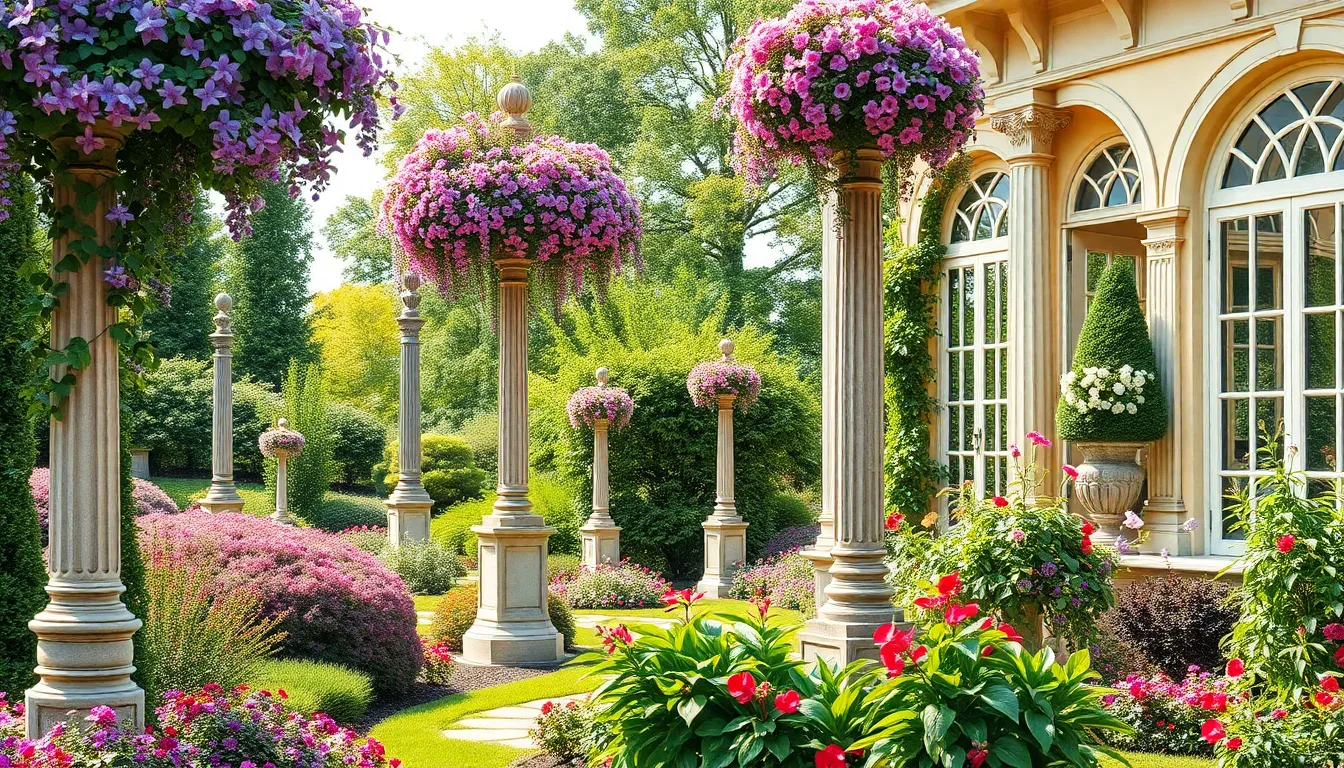
Creating garden obelisks that provide continuous visual appeal requires thoughtful planning for each season. We’ll explore how to maximize your obelisk’s impact throughout the year with strategic plant selections and decorative elements.
Spring Flowering Vine Displays
Clematis transforms our obelisks into stunning vertical flower displays with vibrant blooms in purple, pink, white, and deep burgundy colors. We recommend training these popular climbing vines early in spring for maximum flowering potential throughout the growing season.
Wisteria creates dramatic cascading displays that transform simple obelisks into breathtaking focal points with their iconic purple flower clusters. Training wisteria requires sturdy metal structures since mature vines can become quite heavy once established.
Honeysuckle provides fragrant coverage that quickly envelops obelisk structures while offering sweet scents and colorful tubular blooms in yellow, orange, and red varieties. We find honeysuckle particularly effective for creating privacy screens when multiple obelisks are positioned strategically.
Summer Foliage Arrangements
Lavender benefits from obelisk support as plants spread and develop their characteristic mounded shape while producing fragrant purple spikes throughout summer months. Supporting lavender with decorative structures prevents sprawling and maintains garden organization.
Mandevilla delivers bold summer color with large trumpet shaped flowers in pink, red, and white that continue blooming until first frost. We position mandevilla obelisks in sunny locations where their glossy foliage and showy flowers receive maximum exposure.
Passionflower adds exotic appeal with intricate blooms featuring complex petal arrangements and unique seed pods that provide continued interest after flowering. These vigorous vines quickly cover obelisk structures while attracting butterflies and beneficial insects.
Winter Structural Elements
Evergreen vines maintain visual interest during dormant months by training English ivy or evergreen clematis varieties to preserve lush coverage year round. We select hardy evergreen climbers that withstand freezing temperatures while maintaining their foliage.
Solar powered lighting highlights obelisk architecture during shorter winter days by illuminating structural elements and creating dramatic shadows in evening gardens. Strategic light placement emphasizes the geometric beauty of bare obelisk frames.
Seasonal decorations enhance winter appeal through natural elements like pinecones, dried seed heads, and weather resistant ribbons that add texture and color during sparse months. We rotate decorative themes monthly to maintain fresh visual interest throughout winter.
Small Space Garden Obelisk Ideas for Compact Gardens
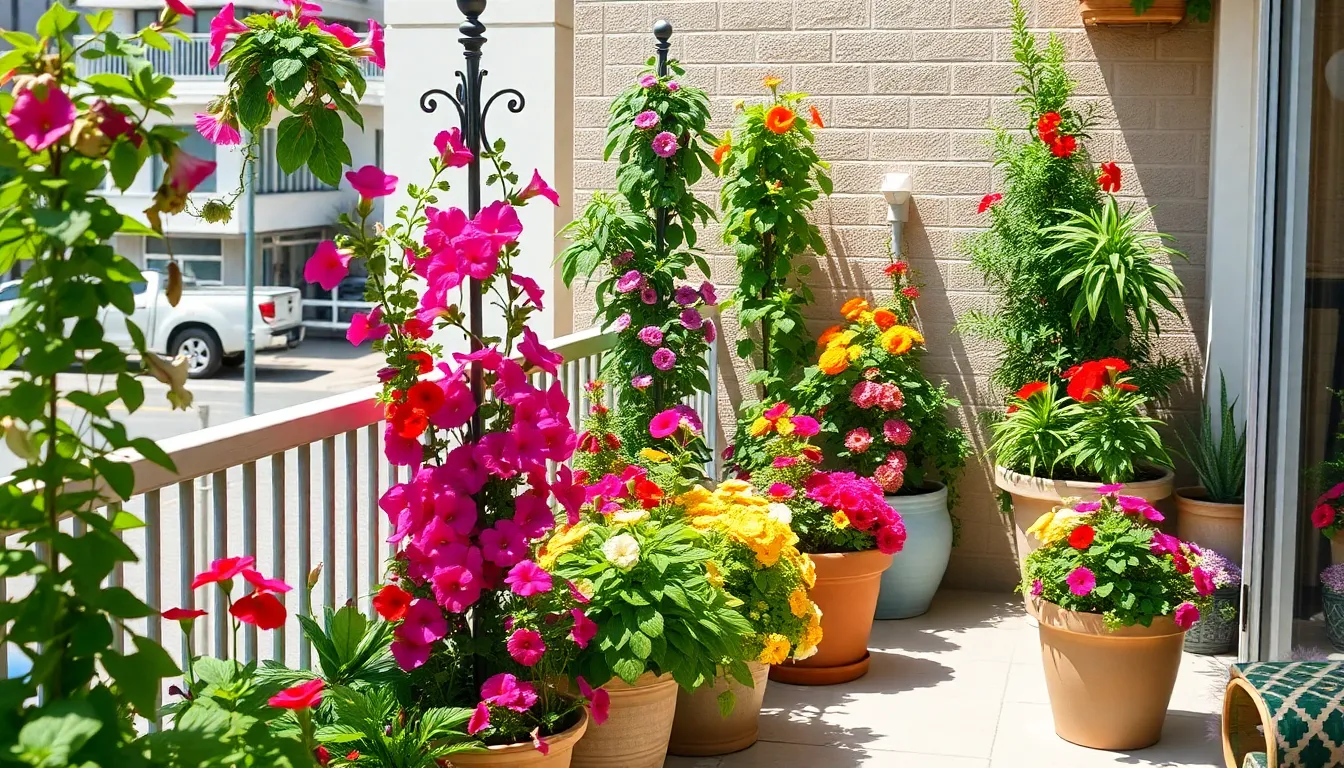
Maximizing limited garden space becomes effortless when we incorporate vertical elements that serve multiple functions. Garden obelisks offer the perfect solution for compact growing areas where every square foot counts.
Container Garden Integration
Large pot obelisks create dramatic focal points while supporting climbing plants in container gardens. We recommend choosing lightweight materials like aluminum or bamboo for easy mobility between containers throughout the growing season.
Multi level planting works exceptionally well when we place smaller flowering annuals around the obelisk base while training vines upward. Container combinations featuring sweet peas, morning glories, or clematis paired with trailing petunias or cascading lobelia maximize visual impact in minimal space.
Seasonal flexibility allows us to move container obelisks to different locations as sunlight patterns change or when we want to refresh our garden design. Wheeled plant caddies make repositioning heavy containers effortless while protecting deck surfaces from scratches.
Balcony and Patio Designs
Corner installations use often overlooked spaces by placing obelisks in tight corners where they add height without consuming valuable floor area. We’ve found that pyramid shaped obelisks work particularly well in corner placements because their tapered design fits naturally into angular spaces.
Privacy screening becomes possible when we train dense climbing vines like jasmine or honeysuckle up patio obelisks. These living screens provide natural barriers while adding fragrance and beauty to outdoor living spaces.
Weather resistant materials ensure our balcony obelisks withstand wind exposure and temperature fluctuations common in elevated locations. Powder coated steel or treated cedar obelisks maintain their appearance and structural integrity through harsh weather conditions.
Vertical Growing Answers
Vegetable production increases dramatically when we use obelisks to support vining crops like peas, beans, and cucumbers in compact spaces. A single 6 foot obelisk can support up to 12 bean plants while occupying less than 4 square feet of ground space.
Succession planting extends our harvest season by training different vegetables up the same obelisk structure throughout the growing year. We plant cool season crops like peas in early spring, followed by warm season beans or cucumbers for continuous production.
Harvest accessibility improves significantly with obelisk grown vegetables because we can easily reach fruits and pods from all sides without stepping into garden beds. This 360 degree access reduces soil compaction while making maintenance tasks like watering and harvesting more efficient.
Large Scale Garden Obelisk Ideas for Spacious Landscapes
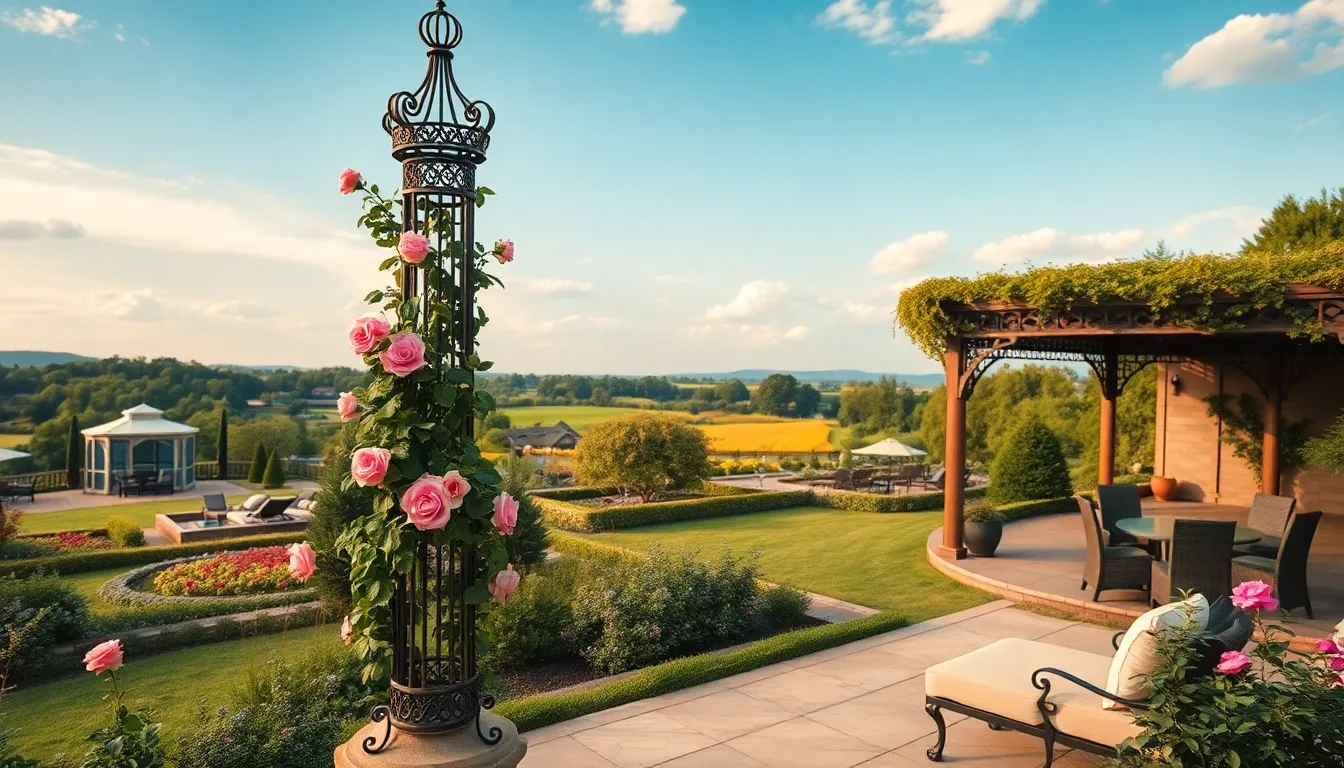
When we have expansive garden spaces at our disposal, obelisks transform into powerful design tools that create stunning vertical drama and architectural interest. These substantial structures can anchor large beds, support vigorous climbing plants, and establish focal points that draw the eye across vast landscapes.
Statement Piece Installations
Grand obelisks serve as commanding centerpieces in formal garden beds, creating immediate visual impact that anchors entire industry sections. We recommend positioning these impressive structures at the heart of circular or rectangular plantings where they’ll naturally draw attention and provide year-round architectural interest.
Decorative obelisks combined with ornate trellises deliver sophisticated visual appeal that endures through all seasons. Metal options like wrought iron or galvanized steel offer exceptional durability for supporting heavy climbing specimens such as rambling roses, clematis montana, or vigorous grape vines that can reach substantial weights.
Material selection between metal and wooden obelisks depends on our desired aesthetic and long-term maintenance preferences. Wooden statement pieces provide warm, natural charm that complements cottage garden styles, while metal structures offer sleek sophistication perfect for contemporary industry designs.
Garden Room Dividers
Strategic obelisk placement creates natural boundaries between different garden zones without blocking precious sunlight or obstructing scenic views. We can establish distinct areas for dining, relaxation, or specialized plantings while maintaining the open feel that makes large gardens so appealing.
Plant integration along divider obelisks enhances their screening effectiveness while adding living beauty to structural elements. Training flowering vines like honeysuckle, jasmine, or climbing hydrangeas transforms these functional barriers into blooming walls that provide privacy and visual separation.
Spacing multiple obelisks in linear arrangements creates impressive garden corridors that guide movement and define pathways. This technique works particularly well for separating ornamental areas from productive vegetable gardens or creating transitions between formal and informal industry sections.
Pathway Marking Elements
Regular obelisk intervals along garden pathways establish rhythm and continuity that guides visitors through expansive industry areas. We suggest spacing these markers every 10 to 15 feet to create a strong visual progression without overwhelming the natural garden flow.
Focal point positioning at path intersections and directional changes helps visitors navigate large garden spaces while creating memorable landmarks. These strategic placements work especially well where main pathways branch toward different garden rooms or feature areas.
Coordinated plant selections for pathway obelisks ensure consistent visual themes while accommodating varying light conditions along different route sections. Using the same climbing varieties like clematis or climbing roses maintains design unity while allowing for seasonal color progression that evolves throughout the growing season.
Themed Garden Obelisk Ideas for Specific Garden Styles

We can transform any garden space by selecting obelisk designs that complement exact landscaping themes. Matching your obelisk style to your garden’s aesthetic creates a cohesive outdoor environment that feels intentionally designed.
Cottage Garden Romance Designs
Wooden obelisks create the perfect romantic foundation for cottage garden charm. We recommend choosing pieces with rustic finishes that blend naturally with the informal beauty of cottage landscapes. Cedar and teak obelisks weather beautifully while supporting climbing roses and clematis that define cottage garden romance.
Climbing flower support becomes effortless when we position wooden obelisks throughout cottage beds. Sweet peas, morning glories, and jasmine create whimsical displays that cascade gracefully down rustic supports. Weathered wood develops character over time, improving the authentic cottage garden atmosphere we’re cultivating.
Floral vine integration works exceptionally well with medium height obelisks ranging from 4 to 6 feet tall. We can create intimate garden rooms by clustering multiple wooden supports near seating areas. Honeysuckle and climbing hydrangeas thrive on these structures while adding fragrance and seasonal interest to our cottage garden retreats.
Formal Garden Symmetrical Layouts
Stone obelisks establish the structured elegance essential for formal garden designs. We position these substantial pieces at pathway intersections and garden room entrances to create visual anchors. Limestone and concrete obelisks provide the weight and permanence that formal gardens require.
Symmetrical placement becomes our primary design strategy when incorporating obelisks into formal layouts. Matching pairs flanking garden gates or positioned at bed corners create the balanced compositions that define formal garden style. We maintain consistent heights and materials throughout the space to achieve professional results.
Topiary highlighting reaches new levels when we position stone obelisks near carefully manicured shrubs. Boxwood spirals and geometric hedges gain dramatic emphasis when paired with tall obelisks. Climbing ivy trained on formal obelisks creates living architecture that enhances rather than competes with existing topiary work.
Mediterranean Style Structures
Terracotta obelisks capture the warm, earthy essence of Mediterranean garden design. We select pieces in natural clay tones that complement olive trees and lavender plantings. These materials age gracefully in sunny locations while supporting the heat loving vines that thrive in Mediterranean climates.
Climbing vine support becomes essential for grapevines and wisteria that define Mediterranean garden character. We install sturdy terracotta or metal obelisks that can handle the substantial weight of mature climbing plants. Bougainvillea and passion vines create the lush, abundant look that Mediterranean gardens are known for.
Mediterranean plant pairing works beautifully when we combine obelisks with drought tolerant perennials. Rosemary, thyme, and oregano planted at the base of vine covered obelisks create functional herb gardens with vertical interest. We can incorporate citrus trained as standards near obelisks to enhance the authentic Mediterranean atmosphere throughout our garden spaces.
Budget-Friendly Garden Obelisk Ideas for Cost-Conscious Gardeners

We can create stunning garden obelisks without very costly by utilizing clever material sourcing and creative design approaches. Smart shopping and resourceful thinking transform ordinary items into beautiful vertical garden features.
Dollar Store Material Hacks
Repurpose old materials from around your home to create unique obelisks that rival expensive store-bought versions. Old pallets, wooden stakes, and broken furniture pieces provide excellent structural foundations for vertical garden supports. We’ve discovered that combining these materials with basic hardware creates surprisingly sturdy results.
DIY construction with common items becomes simple when we use everyday supplies like wire, string, and nails. These basic materials help us tie together sticks or branches to form functional trellis structures. Dollar store zip ties and garden twine work exceptionally well for securing bamboo poles or wooden stakes into pyramid shapes.
Assembly techniques using minimal tools make obelisk construction accessible to everyone. We can create a basic 6-foot obelisk trellis using just a saw and glue for approximately $10. PVC pipe connectors from discount stores help us build lightweight structures that withstand weather conditions.
Free Resource Utilization
Bamboo stick collection from our yards or local areas provides excellent material for teepee-style obelisk structures. We secure these natural poles with twine or small nails to create stable frameworks that support climbing plants beautifully. Fresh bamboo offers flexibility during construction while maintaining strength once dried.
Branch and twig gathering allows us to create rustic obelisk designs that blend naturally with garden environments. Fallen branches from pruning activities or storm cleanup provide sturdy vertical supports. We can arrange these materials in pyramid formations to achieve authentic woodland aesthetics.
Community resource sharing expands our material options through neighborhood exchanges and gardening groups. Local tree trimming services often provide free wood chips and branches suitable for obelisk construction. Garden clubs frequently organize material swaps where members share surplus supplies.
Multi-Purpose Design Answers
Decorative and functional combinations maximize our investment by choosing obelisks that serve dual purposes in garden spaces. We design structures that add visual beauty while supporting climbing plants like roses, clematis, or morning glories. Strategic color coordination ensures these supports enhance rather than distract from surrounding plantings.
Portable design features allow us to move obelisks seasonally or repurpose them in different garden areas throughout the year. Lightweight materials and modular construction techniques make relocation simple when garden layouts change. We can easily transfer these structures from vegetable gardens to flower beds as growing seasons progress.
Container garden integration extends obelisk utility to smaller spaces through pot and planter combinations. We use compact obelisks in flower pots to support climbing vines in patios, balconies, or deck areas. This approach works particularly well for renters or gardeners with limited ground space.
Seasonal versatility ensures our obelisk investments provide year-round value through adaptable design elements. We can modify structures with seasonal decorations or change plant selections to maintain visual interest. Winter lighting additions transform summer plant supports into attractive garden focal points during dormant months.
Conclusion
Garden obelisks offer endless possibilities for transforming our outdoor spaces into stunning vertical displays. Whether we’re working with a generous budget or seeking creative ways to repurpose materials we already have these elegant structures deliver both beauty and functionality.
From supporting climbing roses and vegetable vines to serving as striking architectural focal points obelisks adapt to our garden’s unique needs throughout every season. The variety of materials and styles available means there’s an obelisk solution for every garden aesthetic and skill level.
We encourage you to start with one simple obelisk project and discover how these versatile structures can elevate your garden’s visual appeal while maximizing your growing space. Your plants and visitors will appreciate the added dimension and charm these timeless garden features bring to your outdoor sanctuary.
Frequently Asked Questions
What are garden obelisks and why should I use them?
Garden obelisks are vertical structures that add height and visual interest to outdoor spaces. They serve dual purposes as decorative focal points and functional plant supports for climbing vines, roses, and vegetables. These versatile elements can transform any garden by creating dramatic vertical displays while maximizing growing space, especially in smaller gardens.
What materials work best for garden obelisks?
The best materials include cedar and teak wood for durability and natural beauty, galvanized steel and wrought iron for heavy-duty support, and aluminum for lightweight options. Reclaimed materials like barn wood add rustic charm, while bamboo offers an eco-friendly alternative. Choose materials based on your climate, budget, and desired aesthetic.
Can I make a garden obelisk myself?
Yes! DIY garden obelisks are easy to create using materials like bamboo poles, PVC pipes, or repurposed wood. Simple construction methods include connecting joints with screws or zip ties. Even natural branches and twigs can be fashioned into rustic obelisks. No professional skills are required for basic designs.
How do I decorate my garden obelisk?
Enhance obelisks with mosaic tiles, painted patterns, or carved details. Use weather-resistant paints and stencils for professional results. Natural elements like stone or weathered finishes add timeless appeal. Seasonal decorations and solar lighting can provide year-round interest and highlight the structure’s architectural beauty.
What plants work best with garden obelisks?
Climbing roses, clematis, and honeysuckle are excellent choices for ornamental displays. For vegetable gardens, try beans, peas, cucumbers, and tomatoes. Annual flowering vines like morning glories and sweet peas provide seasonal color. Choose plants based on your obelisk’s height, strength, and your garden’s growing conditions.
How much do garden obelisks cost?
Garden obelisks can be very budget-friendly. DIY versions using repurposed materials, bamboo, or PVC pipes cost under $20. Mid-range wooden or basic metal obelisks range from $30-100. Premium wrought iron or elaborate designs can cost $100-300. Creative material sourcing and community sharing can reduce costs significantly.
Where should I place my garden obelisk?
Position obelisks as focal points in flower beds, at garden entrances, or to create vertical interest in flat landscapes. Consider sunlight requirements for your chosen plants and ensure adequate spacing for growth. In vegetable gardens, place them where they won’t shade other plants. Container gardens can also accommodate smaller obelisks.
How do I maintain my garden obelisk?
Maintenance depends on materials used. Wood obelisks may need annual sealing or staining. Metal structures should be checked for rust and treated as needed. Clean debris regularly and inspect joints for stability. Natural materials like bamboo or branches may need replacement every few years due to weathering.

